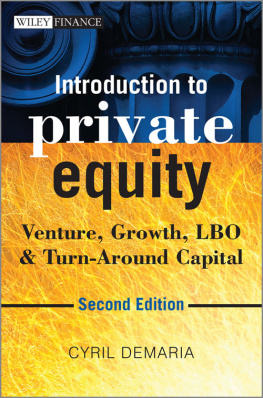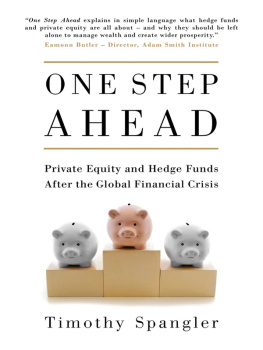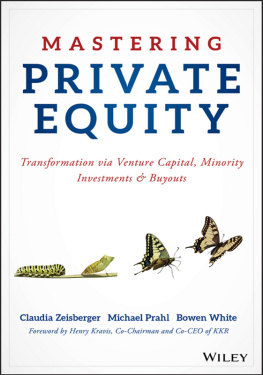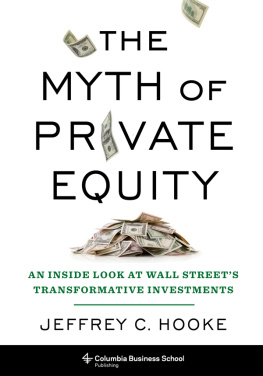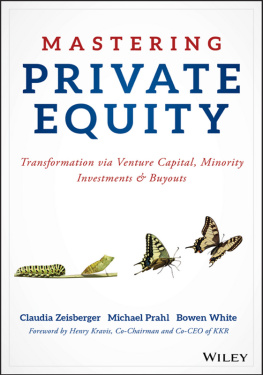For other titles in the Wiley Finance series
please see www.wiley.com/finance
Cover images reproduced by permission of Shutterstock.com
This edition first published 2013
Copyright 2013 Cyril Demaria
First edition published 2010 by John Wiley and Sons, Ltd.
Registered office
John Wiley & Sons Ltd, The Atrium, Southern Gate, Chichester, West Sussex, PO19 8SQ, United Kingdom
For details of our global editorial offices, for customer services and for information about how to apply for permission to reuse the copyright material in this book please see our website at www.wiley.com.
The right of the author to be identified as the author of this work has been asserted in accordance with the Copyright, Designs and Patents Act 1988
All rights reserved. No part of this publication may be reproduced, stored in a retrieval system, or transmitted, in any form or by any means, electronic, mechanical, photocopying, recording or otherwise, except as permitted by the UK Copyright, Designs and Patents Act 1988, without the prior permission of the publisher.
Wiley publishes in a variety of print and electronic formats and by print-on-demand. Some material included with standard print versions of this book may not be included in e-books or in print-on-demand. If this book refers to media such as a CD or DVD that is not included in the version you purchased, you may download this material at http://booksupport.wiley.com . For more information about Wiley products, visit www.wiley.com .
Designations used by companies to distinguish their products are often claimed as trademarks. All brand names and product names used in this book are trade names, service marks, trademarks or registered trademarks of their respective owners. The publisher is not associated with any product or vendor mentioned in this book.
Limit of Liability/Disclaimer of Warranty: While the publisher and author have used their best efforts in preparing this book, they make no representations or warranties with respect to the accuracy or completeness of the contents of this book and specifically disclaim any implied warranties of merchantability or fitness for a particular purpose. It is sold on the understanding that the publisher is not engaged in rendering professional services and neither the publisher nor the author shall be liable for damages arising herefrom. If professional advice or other expert assistance is required, the services of a competent professional should be sought.
Library of Congress Cataloging-in-Publication Data
Demaria, Cyril.
Introduction to private equity : venture, growth, LBO & turn-around capital / Cyril Demaria. - Second edition.
1 online resource.
Includes bibliographical references and index.
Description based on print version record and CIP data provided by publisher; resource not viewed.
ISBN 978-1-118-57189-7 (ebk) - ISBN 978-1-118-57190-3 (ebk) - ISBN 978-1-118-57191-0 (ebk)
ISBN 978-1-118-57192-7 (hbk) 1. Private equity. I. Title.
HG4751
332.6-dc23
2013017574
A catalogue record for this book is available from the British Library.
ISBN 978-1-118-57192-7 (hbk) ISBN 978-1-118-57189-7 (ebk) ISBN 978-1-118-70052-5 (ebk)
ISBN 978-1-118-57190-3 (ebk) ISBN 978-1-118-57191-0 (ebk)
To my family, my friends and my wife Bada.
Foreword to the Second Edition
Private equity can be described as investments in private companies in privately negotiated transactions. This means that private equity is an asset class that is normally opaque, illiquid and very often difficult to analyse.
However, private equity investing offers many advantages compared to investing in public and liquid asset classes. The underlying companies can be acquired in a transaction that does not have to be publicly announced or explained, many times also using an inefficient process leading to an attractive investment. Privately owned companies can be developed without public scrutiny for long-term success. Public companies normally have quarterly reporting requirements and are therefore only targeting short-term benefits. The fund managers who are active in private equity normally have much more information at hand when they make investment decisions compared to investing in public companies. The incentives to management can be fully aligned with the investors, and the fund managers can have tighter control of the companies and can develop them aggressively without having to worry about how every decision is understood by the public markets. Through private equity investments, investors can also possibly invest in industries or niches where there are no public companies.
Private equity is a very complex asset class. Private equity investing is more of an art than other investments that can be analysed and compared quantitatively. Private equity is an asset class where manager selection plays the highest role of all asset classes. Normally, there are not several private equity managers who are in the same state of development of their own activities. Some have decades of experience and some have worked as part of a team for a long time. Some have made several investments in the same industry and some have realized a big portion of their investments. This means that analysing private equity investments and fund managers requires broad skills and a long experience.
Private equity is not as private as it used to be. Because of all the large leveraged buy-outs that occurred at the end of 1980s and the mega-leveraged buy-outs during 2006--08, private equity transactions have been widely reported and followed. Private equity is a long-term asset class and investors will realize the final return long after they have made the decision to invest.
Despite all of the mentioned difficulties and hurdles, Cyril Demaria has been able to write an interesting and extremely well-formulated book about private equity. Cyril has seen and experienced private equity from many angles and in different roles. Cyril has been an investor directly involved in start-up companies and also in more developed and established businesses. Cyril has also been advisor and investor to private equity funds. Most importantly, Cyril has been writing about the private equity industry in many papers and magazines for more than a decade. The experience Cyril has gathered from all of his professional activities, and his passionate interest in private equity, has enabled him to write this book in an easy and understandable way, whilst still giving the reader a very good picture of the asset class and also its pitfalls. In this book Cyril has been able to give the topic of private equity more flavour with a lot of anecdotes and historical references which hopefully show the reader that private equity per se is not a new invention.
I have had the honour of working together with Cyril and have read his articles and papers for many years. Cyril is a very knowledgeable person in private equity; he is critical and does not swallow all of the polished information that is generally written about private equity.
This book opens the world of private equity to the reader in a very clear way, making this opaque asset class more understandable for the reader and hopefully an interesting asset class to invest in.
Acknowledgements
I would like to thank Tom Eriksson for his help in the review of the contents of this book; Werner Coetzee and Jennie Kitchin, of John Wiley & Sons, for their patient and very kind support.
About the Author

